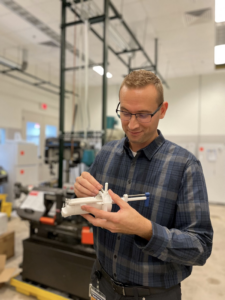Innovation in medical technologies is something of a paradox. On one hand, new technologies that drive innovation can manifest at breakneck speed. On the other hand, the pace at which those technologies breed innovations that reach full commercialization and patient impact can be glacial by comparison.
What have been the most significant changes with potential to impact medtech innovation from a design and development perspective in the past 12 months? What technologies currently consume the largest portions of the industry’s capacity, interest and effort? What do innovators need to know? What might the future hold for technologies with investment ‘behind’ them at high risk of succumbing to the medtech valley of death?
We answer those questions and more in this 2023 State of Medtech Design and Development piece featuring GCMI Medical Director Emily Blum, MD and Director of Design and Development Engineering Saylan Lukas.
 Proceed with great caution on ‘inescapable’ interest in AI for medtech
Proceed with great caution on ‘inescapable’ interest in AI for medtech
According to Emily, large language models, generative AI and how to safely utilize them seem to dominate every industry forum including events, casual conversations and written media forums. However, those technologies are advancing at a faster pace than the industry can handle safely.
Emily says, “Having studied AI and machine learning over the years, I always come back to the question, ‘Because we can, should we? If we train AI to diagnose something, where do the clinicians fit it?’ With previous advances in AI that question resonated greatly with radiologists and pathologists, now we see AI models such as glass.ai able to formulate differential diagnosis from patient complaints.”
Emily advises, “The industry should turn that focus into how AI can offer better quality care. Tools built on AI have a high potential to make clinicians better practicioners improving outcomes and minimizing errors as well. These tools have potential to reduce physician burnout helping them focus more attentively on patients and enhance their lives outside of medicine.”
“The industry needs proper validation for AI tools to work accurately outside of the data on which they are trained,” Saylan says. “In some cases over the past 12 months we have seen inaccuracies after it was released to a larger population beyond the data set that the AI was initially trained on.”
Advisory.com reported on July 24, 2023, “Adam Rodman, co-director of the iMED Initiative at Beth Israel Deaconess Medical Center, said because GPT-4 was trained off human communication, it “shows the same — or maybe even more exaggerated — racial and sex biases as humans.”
“Despite years of training these things to be less terrible, they still reflect many of these more subtle biases,” he added. “It still reflects the biases of its training data, which is concerning given what people are using GPT for right now.”

Dr. Emily Blum
Emily points to Pear Therapeutics as an example of a company with promising AI applications, but one whose regulatory strategy outpaced its reimbursement strategy contributing to serious financial difficulty. This is equal parts a lesson in technology and process from which many Medtech innovators can learn.
“Despite the rise and fall of Pear Therapeutics, there is still high potential for AI to improve access and outcomes at a large population level for mental health including reimbursement,” she says.
While guidance documents exist – including ones released as recently as April 2023 – the speed at which the technologies and those seeking to leverage it in medtech is challenging for regulators, innovators and those who support innovators like GCMI to keep up with appropriate controls.
“It seems like everyone wants to jump right to full blown AI activation on apps with detection capabilities that provide guidance to the user, frequently a surgeon,” Saylan says. “It is possible, but it is also an extremely expensive, time consuming challenge to take on that functionality all at once.
“We recommend starting more simply, gathering data with the intent to ‘add on’ AI in the future. Generally, if you can make the technology work without an app, you’ll get to market faster, gather high value data, generate a better understanding of how it is working and what users want. With that cash flow, you can then invest in the larger clinical study required to prove the safety and efficacy of an AI generated decision making tool for which the regulators will want to see very high volumes of data.”

Saylan Lukas
Sensors sensors (still) everywhere
Shifting gears, there are still sensors everywhere.
“Many of the CreateX and Georgia Tech Capstone projects we support want to add sensors to their devices for every possible reason,” Saylan says. “And rightly so. The sensitivity of new sensors is amazing.”
But the sensor is only as good as the demand for, and delivery of, the accumulated data and its delivery vehicle, usually an app. This is where GCMI’s quality systems and device standards shine.
It bears repeating: carefully consider the claims you need to make for market adoption.
Innovators of any size at any phase should carefully consider what claims they need to make for market adoption, especially for technologies with sensors that generate and disseminate data, particularly data used for clinical decision making. Those decisions have massive implications for the regulatory pathway and associated funding requirements including preclinical and clinical testing.
From GCMI’s 2023 State of Preclinical Testing with Director of Scientific Affairs Evan Goldberg, “Beyond planning, several studies in the past 12 months have had to be pushed back because devices provided by the contract manufacturing organization, or CMO, either weren’t ready or not made appropriately. It’s not just preclinical or histology labs that are having a hard time keeping up, manufacturers are as well.
Production quality and volume for contract manufacturing organizations or CMOs is a problem. Allow for potential delays in test article acquisition and do not expect the first batch to be delivered ‘just in time’ or ‘just right’ for the planned study start, especially for GLP preclinical studies.
 New technologies will likely abandon the EU-first strategy, perfect timing for the FDA TPLC
New technologies will likely abandon the EU-first strategy, perfect timing for the FDA TPLC
The medtech innovation ecosystem consensus is that the EU’s formal regulatory shift from the MDR to the MDD is seismic. Gone are the days in which device innovators start in Europe before taking on U.S. regulatory approval processes. Almost every new medical technology now requires a clinical trial for EU regulatory approval.
Although the European Commission announced in January of this year it would extend deadlines for some certifications in order to avoid shortages, that delay or extension is not expected to slow the shift of technologies seeking U.S. FDA certification for technologies early in their design and development process prior to seeking certification in the EU.
“At the 2023 MEDVIA HealthTech Summit earlier this year, there was a very high volume – in number and noise – of innovators’ frustration with the lack of clarity in the EU’s shift, what it means for many companies’ existence and what it now requires to make new medical technologies available to the European market,” Emily says.
The timing of, and commitment to, the FDA’s Total Product Life Cycle program has high potential to accelerate that shift as well. Industry leaders regularly assert that the FDA is more accessible and actively interested in supporting innovation than it has ever been.
“Medtech innovators should not be afraid of the FDA. Rather, they should embrace the organization, its supportive resources and its willingness to help. Innovators can now interact with them more directly, acquire guidance earlier and more frequently than before,” Saylan says.
Stay tuned for part 2 next week including “Tech Push vs/ Pull,” Manufacturing at Scale and Opportunities Amidst a Challenging R&D and Venture Environment.
